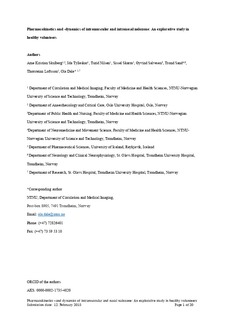Pharmacokinetics and -dynamics of intramuscular and intranasal naloxone: an explorative study in healthy volunteers
Skulberg, Arne Kristian; Tylleskär, Ida; Nilsen, Turid; Skarra, Sissel; Salvesen, Øyvind; Sand, Trond; Loftsson, Thorsteinn; Dale, Ola
Journal article, Peer reviewed
Accepted version

Åpne
Permanent lenke
http://hdl.handle.net/11250/2593952Utgivelsesdato
2018Metadata
Vis full innførselSamlinger
Sammendrag
Purpose
This study aimed to develop a model for pharmacodynamic and pharmacokinetic studies of naloxone antagonism under steady-state opioid agonism and to compare a high-concentration/low-volume intranasal naloxone formulation 8 mg/ml to intramuscular 0.8 mg.
Methods
Two-way crossover in 12 healthy volunteers receiving naloxone while receiving remifentanil by a target-controlled infusion for 102 min. The group were subdivided into three different doses of remifentanil. Blood samples for serum naloxone concentrations, pupillometry and heat pain threshold were measured.
Results
The relative bioavailability of intranasal to intramuscular naloxone was 0.75. Pupillometry showed difference in antagonism; the effect was significant in the data set as a whole (p < 0.001) and in all three subgroups (p < 0.02–p < 0.001). Heat pain threshold showed no statistical difference.
Conclusions
A target-controlled infusion of remifentanil provides good conditions for studying the pharmacodynamics of naloxone, and pupillometry was a better modality than heat pain threshold. Intranasal naloxone 0.8 mg is inferior for a similar dose intramuscular. Our design may help to bridge the gap between studies in healthy volunteers and the patient population in need of naloxone for opioid overdose.